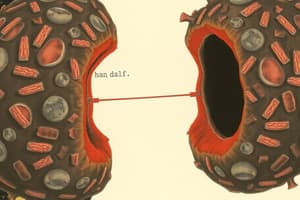Podcast
Questions and Answers
What primarily causes atrophy in cells?
What primarily causes atrophy in cells?
- Higher cell count
- Enhanced blood supply
- Increased metabolic activity
- Decreased protein synthesis (correct)
Which of the following is an example of physiological atrophy?
Which of the following is an example of physiological atrophy?
- Thymus gland during fetal development (correct)
- Atrophy of skeletal muscles due to lack of use
- Atrophy of the heart from ischemia
- Loss of nerve stimulation in muscles
What type of atrophy occurs due to decreased workload?
What type of atrophy occurs due to decreased workload?
- Atrophy of disuse (correct)
- Senile atrophy
- Denervation atrophy
- Ischemia atrophy
Which mechanism is involved in the process of metaplasia?
Which mechanism is involved in the process of metaplasia?
Which type of metaplasia involves the replacement of columnar cells with squamous cells?
Which type of metaplasia involves the replacement of columnar cells with squamous cells?
What is a common cause of ischemia atrophy?
What is a common cause of ischemia atrophy?
Which of the following statements about metaplasia is true?
Which of the following statements about metaplasia is true?
What type of metaplasia occurs when muscle tissue is replaced by bone?
What type of metaplasia occurs when muscle tissue is replaced by bone?
What is the definition of cellular adaptations?
What is the definition of cellular adaptations?
Which of the following is NOT a type of cellular adaptation?
Which of the following is NOT a type of cellular adaptation?
Which cellular adaptation is characterized by an increase in cell size?
Which cellular adaptation is characterized by an increase in cell size?
What is a hallmark of physiologic hypertrophy?
What is a hallmark of physiologic hypertrophy?
Which type of adaptation can occur alongside hypertrophy during pregnancy?
Which type of adaptation can occur alongside hypertrophy during pregnancy?
What is the main mechanism behind hypertrophy?
What is the main mechanism behind hypertrophy?
Which type of cellular adaptation is characterized by a decrease in cell size?
Which type of cellular adaptation is characterized by a decrease in cell size?
What is commonly the result of pathological adaptations?
What is commonly the result of pathological adaptations?
What is hypertrophy primarily characterized by?
What is hypertrophy primarily characterized by?
Which type of hyperplasia occurs in the female breast during puberty?
Which type of hyperplasia occurs in the female breast during puberty?
What is an example of pathologic hypertrophy?
What is an example of pathologic hypertrophy?
What characterizes hyperplasia?
What characterizes hyperplasia?
What mechanism leads to compensatory hyperplasia?
What mechanism leads to compensatory hyperplasia?
Which of the following is NOT a characteristic of atrophy?
Which of the following is NOT a characteristic of atrophy?
What typically triggers pathologic hyperplasia?
What typically triggers pathologic hyperplasia?
Which of the following is an example of physiologic hyperplasia?
Which of the following is an example of physiologic hyperplasia?
What type of cellular adaptation is characterized by a change or replacement of cell type?
What type of cellular adaptation is characterized by a change or replacement of cell type?
Which condition is associated with squamous metaplasia in the lower esophagus?
Which condition is associated with squamous metaplasia in the lower esophagus?
Which of the following is the most common cause of cell injury?
Which of the following is the most common cause of cell injury?
What is the difference between reversible and irreversible cell injury?
What is the difference between reversible and irreversible cell injury?
Which of the following factors is NOT involved in the etiology of cell injury?
Which of the following factors is NOT involved in the etiology of cell injury?
What process describes an increase in the number of cells?
What process describes an increase in the number of cells?
Which change occurs in the respiratory tract due to smoking?
Which change occurs in the respiratory tract due to smoking?
Which type of cell injury is characterized by functional and structural alterations that are correctable?
Which type of cell injury is characterized by functional and structural alterations that are correctable?
Flashcards are hidden until you start studying
Study Notes
Cellular Adaptations
- Cells adapt to stress in response to various stimuli.
- Adaptations can be reversible and are changes in number, size, phenotype, metabolic activity, or functions of cells.
- Physiologic adaptations are responses to normal stimulation by hormones or chemical mediators.
- Pathologic adaptations are responses to stress that allow cells to escape injury.
Types of Cellular Adaptations
- Hypertrophy: Increase in cell size, leading to increased organ size.
- Caused by increased synthesis of structural proteins and organelles.
- Affects cells incapable of proliferation, like cardiac muscle, skeletal muscle, and nerve cells.
- Can occur physiologically (e.g., skeletal muscle hypertrophy in bodybuilders) or pathologically (e.g., left ventricular hypertrophy due to hypertension).
- Hyperplasia: Increase in cell number, leading to increased organ size.
- Usually caused by hormonal stimulation.
- Involves the production of new cells from stem cells.
- Can occur physiologically (e.g., hormonal hyperplasia of the breast during pregnancy) or pathologically (e.g., endometrial hyperplasia due to excess estrogen).
- Atrophy: Decrease in cell size or number, leading to decreased organ size.
- Results from decreased protein synthesis and increased proteolysis.
- Can occur physiologically (e.g., atrophy of fetal organs like the thymus) or pathologically (e.g., atrophy of muscles due to immobilization).
- Common causes of pathologic atrophy include:
- Decreased workload
- Loss of innervation
- Diminished blood supply
- Inadequate nutrition
- Pressure atrophy
- Metaplasia: Reversible change where one cell type is replaced by another.
- Caused by persistent stress or irritation.
- Involves reprogramming of tissue stem cells or colonization by differentiated cells from adjacent sites.
- Can be epithelial (e.g., squamous metaplasia in the respiratory tract due to smoking) or mesenchymal (e.g., Osseous metaplasia in muscle after injury).
Cell Injury
- Cell injury results in cellular dysfunction and loss of function.
- Cell response to injury depends on the type of cell and the severity of the injury.
- Injury can be reversible or irreversible.
Etiology of Cell Injury
- Hypoxia and Ischemia: Oxygen deficiency is the most common cause of cell injury.
- Physical agents: e.g., trauma, temperature extremes, radiation, electrical shock.
- Chemical agents and drugs: e.g., poisons, drugs, pollutants.
- Microbial agents: e.g., bacteria, viruses, fungi, parasites.
- Immunologic agents: e.g., autoimmune reactions, hypersensitivity reactions.
- Nutritional derangements: e.g., deficiencies, excesses.
- Ageing: contributes to cellular deterioration.
- Psychogenic diseases: e.g., stress-related disorders.
- Iatrogenic factors: injury caused by medical treatment.
- Idiopathic diseases: diseases with unknown causes.
- Genetic causes: e.g., inherited metabolic disorders.
Cell Injury: Types
- Reversible cell injury: functional and structural alterations are correctable if the damaging stimulus is removed.
- Irreversible cell injury: leads to cell death.
Studying That Suits You
Use AI to generate personalized quizzes and flashcards to suit your learning preferences.




